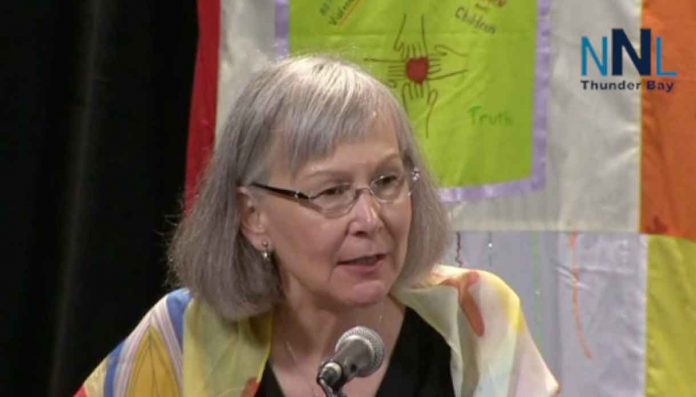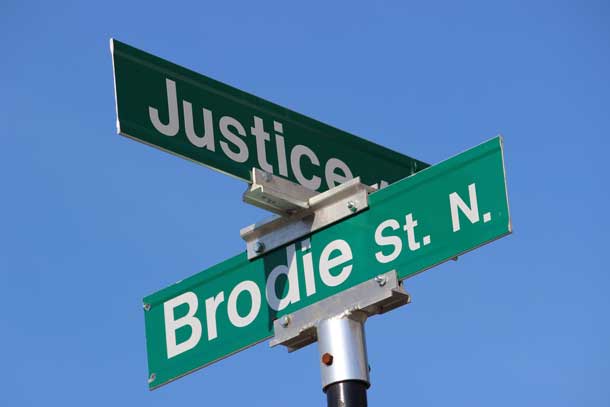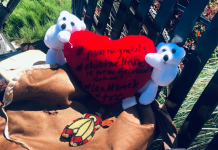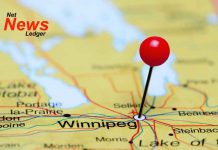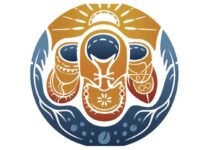During her opening remarks Monday, chief commissioner Marion Buller pronounced the final report of the National Inquiry into Missing and Murdered Indigenous Women and Girls would be like holding up a “mirror” to Canada.
It’s a staggering reflection.
The epidemic of violence Indigenous women and girls have experienced, and continue to endure, is a national emergency.
“If you’re not outraged, you’re not paying attention,” grandmother Bernie Williams says in the report. “This is every Canadian’s responsibility not to turn a blind eye.”
“If you’re not outraged, you’re not paying attention. This is every Canadian’s responsibility not to turn a blind eye.” -Bernie Williams
The 1,200-page report, including more than three years of research and 2,300 testimonies from hearings across the country, offers many difficult truths.
Perhaps the most important one is we still don’t know how bad things really are. The number of missing and murdered Indigenous women and girls has been described in the thousands, but the commissioners state no agency “knows an exact number.”
This is because the report is incomplete. Given an original two-year mandate, the inquiry was beset with problems (staff departures, conflicts with families, and government meddling) as difficult and complex as the issue itself. When the commissioners asked for a two-year extension from the federal government, they received six months.
“In doing so, governments chose to leave many truths unspoken and unknown,” the commissioners say.
The most important aspect of the report is the claim Indigenous women and girls have experienced a “genocide” in “state actions and inactions rooted in colonialism and colonial ideologies,” such as the “Indian Act, the Sixties Scoop, residential schools and breaches of human and Indigenous rights, leading directly to the current increased rates of violence, death, and suicide in Indigenous populations.”
Much has been made about the use of the term genocide; much less has been made with how careful the commissioners were with using it.
“The national inquiry acknowledges that the determination of formal liability for the commission of genocide is to be made before judicial bodies,” a supplementary report explains.
“However, the information and testimonies collected by the national inquiry provide serious reasons to believe that Canada’s past and current policies, omissions, and actions towards First Nations peoples, Inuit and Métis amount to genocide.”
The commissioners go on to explain in detail how the two conditions for genocide to occur — actus reus (physical intention) and mens rea (mental intention) — have been committed by Canada.
In the end, it is simple: any policy or practice designed and delivered to exterminate a race — whether it succeeds or not — is genocidal.
In the end, it is simple: any policy or practice designed and delivered to exterminate a race — whether it succeeds or not — is genocidal.
Many list the five “acts committed with intent to destroy, in whole or in part, a national, ethnical, racial or religious group” as defined by the 1948 Convention on the Prevention and Punishment of the Crime of Genocide, but the bottom line is: genocide never looks the same. The end result — death, destruction, and suffering — is the same.
In other words, making people dress or wear their hair a certain way, labelling them with names, or unjustly and forcibly controlling their movements are all instances of genocide.
It doesn’t matter if genocide happens fast (such the Holocaust or in Rwanda) or over 150 years.
Genocide is genocide is genocide.
And, whether it be in the 1991 Aboriginal Justice Inquiry, 1996 Royal Commission on Aboriginal Peoples, or 2015 Truth and Reconciliation Commission of Canada, the conclusion is the same.
Consistently, from the past and into today, Canada has sought to target, exterminate or assimilate Indigenous peoples by undermining, attacking, and replacing their cultures, identities and governments.
Indigenous lives are still dictated by Canada (see: Indian Act), children are still removed from our communities (see: child welfare and youth jails), and no Indigenous government is free from the control of the minister of Indigenous affairs (see: chiefs and councils).
The outcome of all of these acts has resulted in the death, destruction, and suffering — the genocide — of Indigenous women and girls.
The inquiry states Indigenous women and girls are “12 times more likely to be murdered or missing than any other women in Canada, and 16 times more likely than Caucasian women. In Manitoba and Saskatchewan, they are 19 times more likely than Caucasian women.”
It offers 231 all-encompassing “calls for justice,” which Buller claims are “legal imperatives.”
For too long, this has been one of Canada’s worst kept secrets, resulting in the deaths of thousands of our sisters, aunties, grandmothers, daughters, and nieces.
These are directed at “all governments” to develop “national action plans” to address inequities Indigenous women and girls experience in the definition and delivery of Indigenous and treaty rights across Canada. It calls upon public and private institutions in areas of justice, health, child welfare, transportation, natural resources to ensure the safety of Indigenous women and girls, while also including their perspectives in delivery of their services.
The report also calls on all Canadians to enact justice.
“Each person has a role to play in order to combat violence against Indigenous women, girls and 2SLGBTQQIA (two-spirit, lesbian, gay, bisexual, transgender, queer, questioning, intersex and asexual) people. Beyond those calls aimed at governments or at specific industries or service providers, we encourage every Canadian to consider how they can give life to these calls for justice.”
If anything, the final report of the Inquiry is overwhelming — but so is the issue of 150 years of violence against Indigenous women and girls.
For too long, this has been one of Canada’s worst kept secrets, resulting in the deaths of thousands of our sisters, aunties, grandmothers, daughters, and nieces.
It stops if we look at ourselves and say, “No more.”
Together. Now.
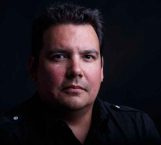 Niigaan Sinclair
Niigaan Sinclair
Originally appeared in the Winnipeg Free Press on June 1, 2019. Republished with the permission of the author


